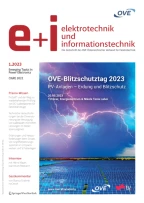Die jährlichen Schäden an elektronischen Einrichtungen durch die Einwirkungen von direkten bzw. nahen Blitzschlägen sind enorm. Leider gibt es nur sehr vage Schätzungen der Schäden durch Blitzschlag, da diese durch unterschiedlichste Versicherungspakete abgedeckt werden, bzw. daraus resultierende Folgeschäden, wie Betriebsunterbrechungen, oft gar nicht versichert sind. Im Sinne der EMV-Grundstruktur Störquelle – Übertragungsweg – Störsenke stellt die Blitzentladung eine natürliche Störquelle dar. Die Eigenschaften dieser Störquelle sind einerseits bestimmt durch die Stromparameter der verschiedenen Blitzstromkomponenten und anderseits durch die Kenngrößen der mit der Entladung verknüpften elektromagnetischen Felder. In den Vorschriften zum Blitzschutz IEC 62305-3 (IEC, 2005) findet man Kennwerte für die zu erwartenden Blitzströme, IEC 62305-4 (IEC, 2005) behandelt den Schutz von elektrischen und elektronischen Einrichtungen in Gebäuden im Falle eines direkten oder nahen Blitzschlags. In Anlehnung an die zu erwartenden Störgrößen wurden in der Vergangenheit verschiedenste Prüfimpulse für Stoßströme und Stoßspannungen entwickelt, die auch zum Teil bei der EMV-Prüfung von Geräten zum Einsatz kommen.
Annual costs of damages caused by direct or nearby lightning on electric and electronic infrastructure are enormous. Unfortunately, there are only rough estimates of the total costs because they are covered by different insurance packages, and often costs for the lightning caused service interruptions are not recorded or insured at all. Lightning is a natural source of current and electromagnetic field in terms of the electromagnetic compatibility concept source – coupling path – receiver, whose properties are determined by the parameters of the different lightning current components and their corresponding EM fields. In the standard for lightning protection IEC 62305-3 (IEC, 2005) parameters of the lightning current are listed. IEC 62305-4 (IEC, 2005) deals with the protection of electronic equipment in case of a direct or nearby lightning strike. In the past different current and voltage pulses have been specified to simulate the effect of lightning strikes and some of them are also applied in EMC tests.
Literatur
Baba, Y., Rakov, V. A. (2005): On the use of lumped sources in lightning return stroke models. J. Geophys. Res. 110: D03101.
Berger, K., Vogelsanger, E. (1965): Messung und Resultate der Blitzforschung derJahre 1955…1963 auf dem Monte San Salvatore. Bull. SEV 56(1): 1–22.
Bermudez, J. L., Rachidi, F., Rubinstein, M., Janischewskyj, W., Shostak, V., Pavanello, D., Chang, J. S., Hussein, A. M., Nucci, C. A., Paolone, M. (2005): Far-field-current relationship based on the TL model for lightning return strokes to elevated strike objects. IEEE Trans. Electromagn. Compat. 47(1): 146–159.
Diendorfer, G., Mair, M., Pichler, H. (2005): Blitzstrommessung am Sender Gaisberg. Forschung im Verbund, Schriftenreihe Band 89, 2005 (http://www.verbund.at/at/konzern/forschung_umwelt/forschung/band_089.pdf/.)
IEC 62305-1 Ed. 1.0: Protection against lightning – Part 1: General principles, 2006.
IEC 62305-2 Ed. 1.0: Protection against lightning – Part 2: Risk management, 2006.
IEC 62305-3 Ed. 1.0: Protection against lightning – Part 3: Physical damage to structures and life hazard, 2006.
IEC 62305-4 Ed. 1.0: Protection against lightning – Part 4: Electrical and electronic systems within structures, 2006.
Janischewskyj, W., Shostak, V., Barratt, J., Hussein, A. M., Rusan, R., Chang, J.-S. (1996): Collection and use of lightning return stroke parameters taking into account characteristics of the struck object. In: Proc. 23rd Int. Conf. Lightning Protection, Florence, Italy, 1996, 16–23.
ÖVE/ÖNORM EN 61000-4-9+A1: Elektromagnetische Verträglichkeit (EMV) – Teil 4–9: Prüf- und Messverfahren – Prüfung der Störfestigkeit gegen impulsförmige Magnetfelder, 2002.
Rachidi, F., Janischewskyj, W., Hussein, A. M., Nucci, C. A., Guerrieri, S., Kordi, B., Chang, J.-C. (2001): Current and electromagnetic field associated with lightning-return strokes to tall towers. IEEE Trans. Electromagn. Compat. 43(3): 356–367.
Rakov, V. A. (1998): Review and evaluation of lightning return stroke models including some aspects of their application. IEEE Trans. on Electromagn. Compat. 40(4): 403–426.
Rakov, V. A. (2001): Transient response of a tall object to lightning. IEEE Trans. Electromagn. Compat. 43(4): 654–661.
Rakov, V. A., Uman (2003): Lightning: physics and effects. Cambridge University Press.
Schoene, J., Uman, M. A., Rakov, V. A., Kodali, V., Rambo, K. J., Schnetzer, G. H. (2003): Statistical characteristics of the electric and magnetic fields and their time derivatives 15 m and 30 m from triggered lightning. J. Geophys. Res. 108 (D6): 4192.
Schulz, W., Cummins, K., Diendorfer, G., Dorninger, M. (2005): Cloud-to-ground lightning in Austria: A 10-year study using data from a lightning location system. J. Geophys. Res. 110: D09101; DOI:10.1029/2004JD005332.
Author information
Authors and Affiliations
Rights and permissions
About this article
Cite this article
Diendorfer, G. Die Blitzentladung als EMV-Störquelle. Elektrotech. Inftech. 123, 34–38 (2006). https://doi.org/10.1007/s00502-006-0316
Issue Date:
DOI: https://doi.org/10.1007/s00502-006-0316
